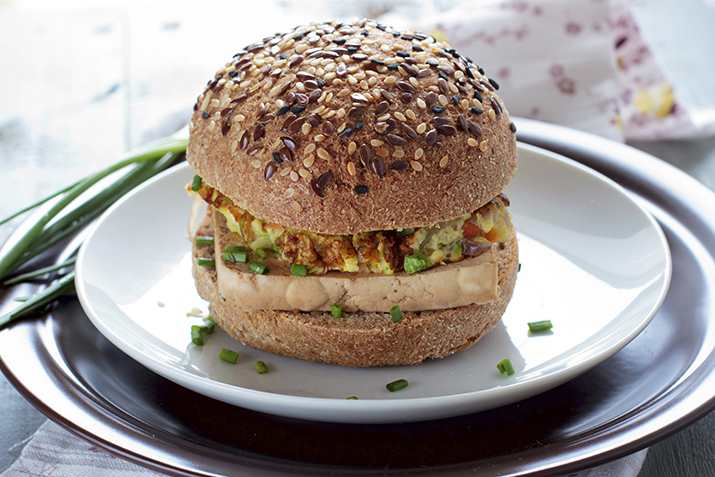Crunchy cornmeal on the outside and Southwestern flavors on the inside, these bean burgers please all kinds of eaters.
Make burgers one day in advance to save time.
Ingredients
Burgers
- 1/2 cup water
- 1/4 cup quinoa, rinsed (see Note)
- 3 tablespoons extra-virgin olive oil, divided
- 1/2 cup chopped red onion
- 1 clove garlic, minced
- 2 1/2 cups cooked pinto beans, well drained
- 1 teaspoon smoked paprika
- 1/2 teaspoon ground toasted cumin seeds (see Tip)
- 3 tablespoons chopped fresh cilantro
- 3 tablespoons cornmeal, plus 1/3 cup for coating burgers
- 1/2 teaspoon salt
- Freshly ground pepper to taste
- 6 whole-wheat hamburger buns, toasted
- 6 lettuce leaves
Guacamole
- 1 ripe avocado
- 2 tablespoons finely chopped fresh cilantro
- 1 tablespoon lemon juice
- 2 teaspoons finely chopped red onion
- 1 clove garlic, minced
- 1/8 teaspoon cayenne pepper, or more to taste
Preparation
- Bring water to a boil in a small saucepan. Add quinoa and return to a boil. Reduce to a low simmer, cover and cook until the water has been absorbed, about 10 minutes. Uncover and let stand.
- Heat 1 tablespoon oil in a medium skillet over medium heat. Add 1/2 cup onion and garlic and cook, stirring occasionally, until soft and fragrant, about 3 minutes. Add beans, paprika and ground cumin and mash the beans to a smooth paste with a potato masher or fork. Transfer the mixture to a bowl and let cool slightly. Add the quinoa, 3 tablespoons cilantro, 3 tablespoons cornmeal, 1/2 teaspoon salt and pepper; stir to combine.
- Form the bean mash into 6 patties. Coat them evenly with the remaining 1/3 cup cornmeal and transfer to a baking sheet. Refrigerate for 20 minutes.
- To prepare guacamole: Mash avocado with a potato masher or fork. Stir in 2 tablespoons cilantro, lemon juice, 2 teaspoons onion, garlic, cayenne and 1/8 teaspoon salt.
- Preheat oven to 200°F.
- Heat 1 tablespoon oil in a large cast-iron (or similar heavy) skillet over medium-high heat. Reduce heat to medium and cook 3 burgers until heated through and brown and crisp on both sides, 2 to 4 minutes per side. Transfer to the oven to keep warm. Cook the remaining 3 burgers with the remaining 1 tablespoon oil, reducing the heat as necessary to prevent over-browning. Serve the burgers on buns with lettuce, tomato and the guacamole.
Tips & Notes
- Toast cumin seeds in a small skillet over medium heat, stirring occasionally, until very fragrant, 2 to 5 minutes. Let cool. Grind into a powder in a spice mill or blender.
- Quinoa is a delicately flavored, protein-rich grain. Rinsing removes any residue of saponin, quinoa's natural, bitter protective covering.
Authored by Eatingwell.com. Reprinted by permission from StrongerTogether.coop. Find articles about your food and where it comes from, recipes and a whole lot more at www.strongertogether.coop.








